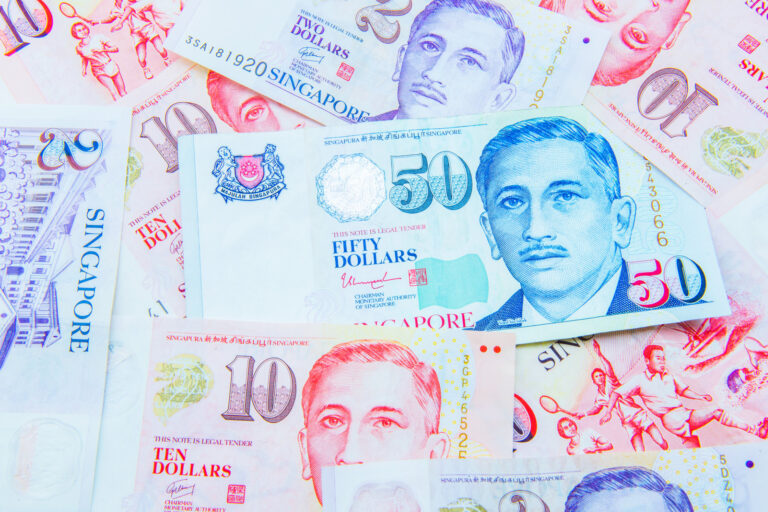How much do you know about the Feng Shui tales associated with Singapore coins and banknotes? Prepare your wallets and embark with us on a journey through Singapore currency.
Table of Contents
Singapore Currency Legend: Bagua Symbol in Singapore $1 coin
Let’s begin with a tale. Those with money can support us financially, while those without can simply enjoy the story. Take out a one-dollar coin. Have you noticed that it’s the most unique among all coins? Its octagonal shape is reminiscent of the Bagua.
According to a popular folk tale, around 1985, Singapore’s founding Prime Minister, Lee Kuan Yew, visited the renowned Buddhist monk, Venerable Hong Chuan, prior to the opening of the metro system. The insightful monk warned him that constructing the metro line over the dragon vein could disrupt Singapore’s excellent Feng Shui.
The solution? Have everyone carry an octagonal diagram or Bagua. However, given Singapore’s multicultural and multi-religious society, it was impractical to expect everyone to carry a Bagua.
Ingeniously, Lee Kuan Yew decided to imprint the Bagua’s shape onto the one-dollar coin, enabling virtually everyone to carry a Bagua.
The truth of this legend remains unknown. Still, in September 1987, a new one-dollar coin featuring an octagonal border began circulation, coinciding with the launch of Singapore’s first metro line from Yio Chu Kang to Toa Payoh a few months later.
Singapore Currency Iconic Institutions: Discovering Singapore on the $2 Note
Speaking of Bagua and Feng Shui, you can find more such coins in Singapore. But before we reveal more, let’s maintain the suspense and continue our journey:
Next, take out a two-dollar note. Do you recognize these three buildings?
Reveal: These are Singapore’s three famous institutions – Building No.1 is Victoria Bridge School, Building No.2 is the former site of Raffles College, and Building No.3 is the College of Medicine Building.
According to the Victoria School website, the current Victoria School on Siglap Link is the successor of Victoria Bridge School. The old Raffles College site is on Bras Basah Road, which is now the location of Raffles City. The College of Medicine Building is located in the Central Hospital Garden on College Road, now housing the Ministry of Health and several medical institutions.
Singapore Currency Natural Heritage: The Majestic Tembusu Tree on Singapore’s $5 Note
Unfortunately, the original buildings of Victoria School and Raffles College no longer exist, with only the College of Medicine Building remaining. However, don’t worry – the landmark on the five-dollar note is much more accessible.
This is the Tembusu tree in the Botanic Gardens. This tree, imprinted on the Singapore five-dollar bill, is also known as the “five-dollar tree.” Since the establishment of the Singapore Botanic Gardens in 1859, it has stood there for over 150 years.
Those interested can visit the Botanic Gardens, find this magnificent tree on the right side of Swan Lake, at “Lawn E.”
After visiting the sights, let’s explore the artistry. I’ve always thought money is the most beautiful form of art. Money isn’t everything, but without it, everything becomes nothing. Now, let’s proceed to the more valuable one.
Singapore Currency Musical Fusion: Instruments and National Treasures on the $50 Note
On the left side of the back of the fifty-dollar note, there are instruments representing Singapore’s four major races – the eastern Pipa, the western Violin, the Indian classical instrument Sitar, and the Malay drum Kompang. To the right are two “national treasure-level” paintings.
In the “foreground” are two playful monkeys, taken from the famous painting “Two Gibbons Amidst Vines” by the late Nanyang painter Chen Wen Hsi, currently in the collection of the National Museum of Singapore.
The other “background” is the painting “Drying Salted Fish” by Nanyang painter Cheong Soo Pieng, currently held by the National Gallery.
In Singapore, you can find such heartwarming and sentimental coins. Here, there’s more than just Feng Shui and art.
Cultural Significance: Asian Traditions in Currency
In conclusion, the legends and symbolism surrounding Singapore currency add an intriguing layer of cultural significance to these everyday objects. From the Feng Shui tales to the representation of iconic institutions and artistic masterpieces, Singapore coins and banknotes carry stories that connect with the nation’s history, beliefs, and values.
Now, we invite you to reflect on this journey through Singapore currency. What is your perspective on the fusion of folklore, art, and symbolism in everyday objects? Have you discovered any fascinating tales or hidden meanings in the currency of your own country?
Share your thoughts and experiences, and let the stories of coins and banknotes continue to spark curiosity and appreciation for the rich tapestry of our world’s currencies.
What currency is used in Singapore?
The official currency of Singapore is the Singapore Dollar (SGD). It is represented by the symbol “$” and the currency code SGD.
Where can I exchange currency in Singapore?
Currency exchange services can be found at various locations in Singapore, including banks, licensed money changers, and some hotels and shopping centers. It is advisable to compare rates and fees before exchanging currency to get the best value.
Are credit cards widely accepted in Singapore?
Yes, credit cards are widely accepted in Singapore, including Visa, Mastercard, American Express, and other major international card networks. Most establishments, including shops, restaurants, hotels, and tourist attractions, accept credit cards. However, it is always advisable to carry some cash for smaller establishments that may not accept cards.
Can I use foreign currency in Singapore?
While some larger establishments may accept major foreign currencies like US Dollars or Euros, it is generally recommended to use Singapore Dollars for transactions in Singapore. Foreign currency payments may incur additional charges or unfavorable exchange rates.
Are there any unique features on Singaporean banknotes?
Yes, Singaporean banknotes have several unique features. They incorporate advanced security features like holographic strips, watermarks, and color-shifting ink to deter counterfeiting. Singapore’s banknotes also showcase iconic landmarks, national symbols, and cultural elements, making them visually appealing and reflective of the country’s heritage.



